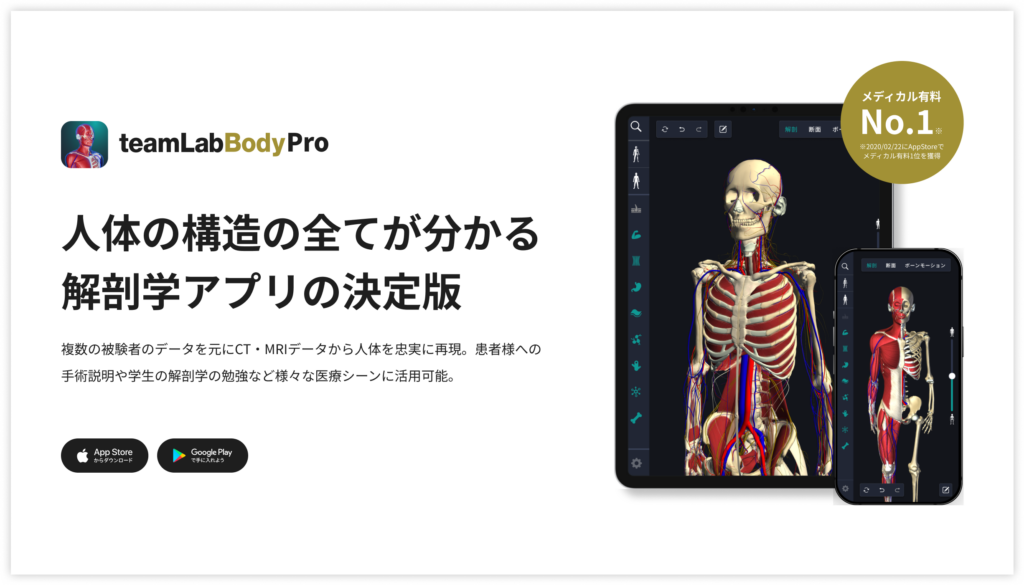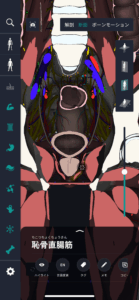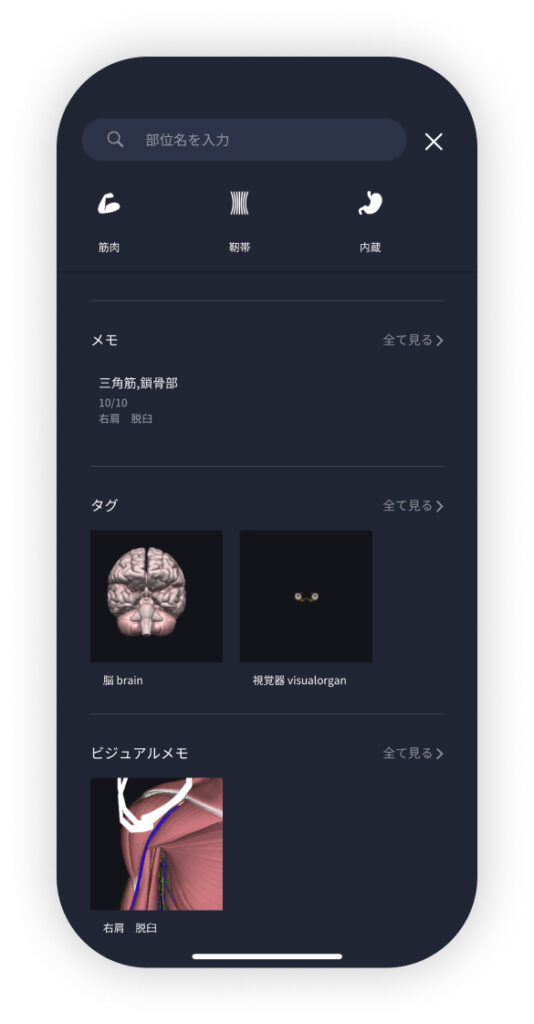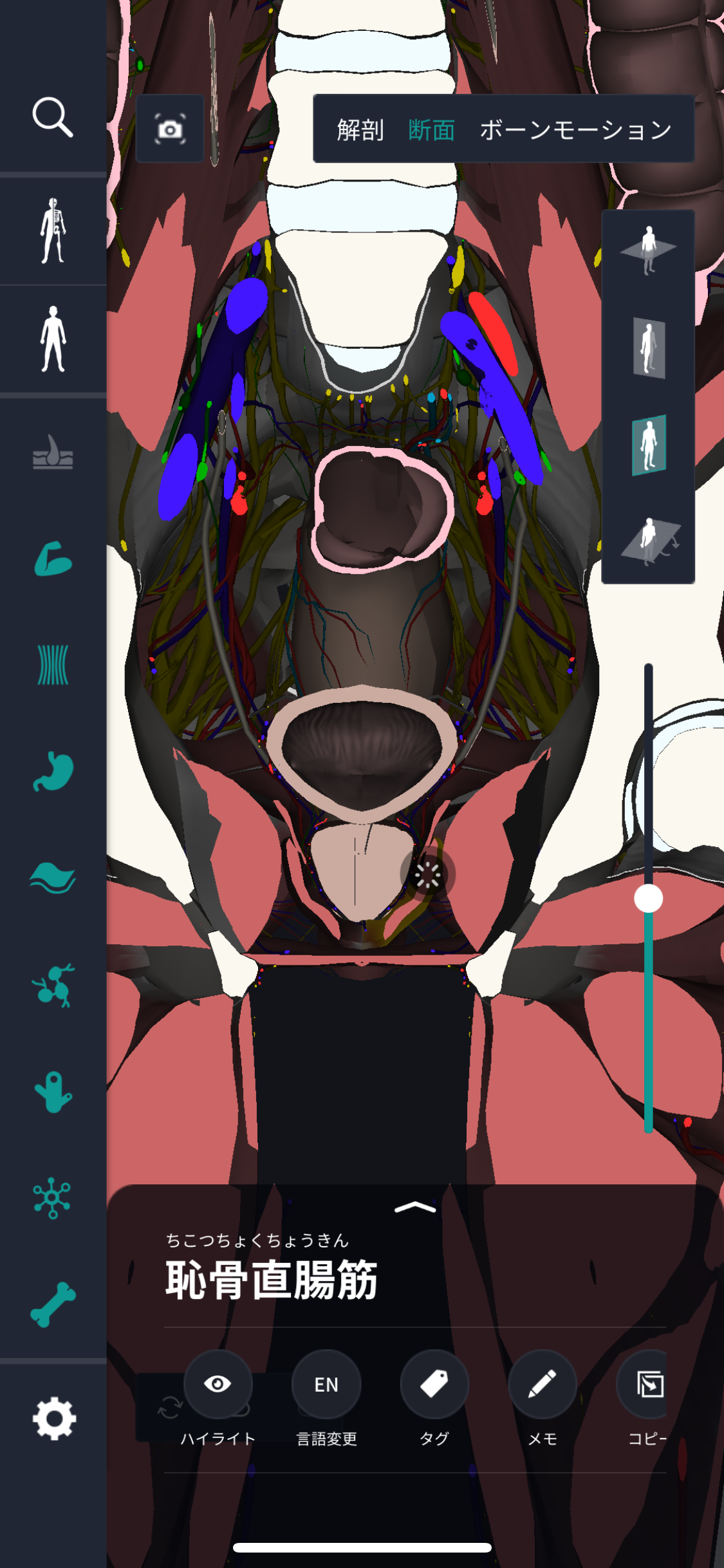beginning
In this article, I will explain effective study methods, starting with knowledge of specialized parts in human anatomy.
In human anatomy, it is necessary not only to memorize the names of various organs, muscles, and bones, but also to remember where they are located in the body. Therefore, it is necessary to learn as efficiently as possible.
I hope you can read this article and use the app to deepen your understanding even a little bit.
Now, I'll explain the details about the “puborectal muscle” and how to study human anatomy.
teamLab Body Pro Free Download
A 3D anatomy app that shows all the structures of the human body
Download teamLab Body Pro here!

What is the puborectal muscle?
In the anatomy application, you can view a selection of anatomy 3D models. In this model, there are various observation methods such as surfaces, cross-sections, and nervous systems. This time, I'll explain using an anatomy application.
About the puborectal muscle

The pubic rectus muscle (pubic rectal muscle) is one of the main muscles that make up the bottom of the pelvis, and it plays a very important role as part of the levator anal muscle group. Anatomically, the pubic-rectal muscle is a muscle that connects the pubic bone to the rectum, and mainly supports the pelvic floor and contributes to forming the angle of the rectum. This muscle, along with other muscles in the levator anus muscle group (pubocococcygeus muscle, iliococcygeus muscle), forms the pelvic floor and is involved in normal rectal and anal function. Another important function of the puborectal muscle is to adjust the position and shape of the rectum by contracting the entire levator anus muscle group to help defecation. Specifically, it maintains the angle of the rectum through normal contractions and helps hold stools by increasing tension. Also, when defecating, this muscle relaxes, and the rectum straightens, making it easier to defecate. The position of the puborectal muscle starts behind the pubic bone and runs backwards through the outside of the rectum. This muscle has a fibrous structure and is closely connected to other muscles in the pelvic floor. Furthermore, some muscle fibers running towards the coccyx form a complex network with the levator anal muscle group, increasing the overall pelvic bearing capacity. As an anatomical structure of the pelvis, the pubic-rectal muscle is one of the most important elements that make up the pelvic floor, and is essential for excretory function and support for pelvic organs. Outwardly, it starts on the inner side of the pubis, runs backwards towards the rectum, and plays a role as an anal levator muscle group. From the above anatomical point of view, the pubic rectal muscle is very important as part of the pelvic floor muscle group and plays a role in maintaining the position and function of the rectum. Therefore, the puborectal muscle is understood as an essential structure for pelvic health.
Study points
The location and structure of the puborectal muscle
The pubic rectus muscle is located deep in the pelvic floor and is one of the main muscles belonging to the levator anal muscle group. This muscle starts at the posterior surface of the pubis and extends towards the coccyx. Its run is curved to cross the pelvic floor and is arranged to surround the sides of the anus and rectum. The pubic-rectal muscle starts from the left and right pubic bones, runs backwards to surround the anus, then fuses in the center and comes into contact with the rectum. The internal structure has a thin smooth muscle structure, and the fibers run toward the coccyx and perform a firm supporting function. It works in close cooperation with other surrounding muscles (pubic-coccygeal muscle and ilioccygeal muscle) and plays a role in enhancing overall pelvic stability. This muscle also regulates intra-anal pressure and manages bowel movements by providing uninterrupted support between the anus and rectum. Structurally, it is thought that it coordinates with other muscles in the pelvic floor and plays a complex role in contributing to anal opening/closing movements and maintaining the shape of the rectum. This effectively responds to daily changes in abdominal pressure and maintains stable pelvic function.
The role and function of the puborectal muscle
The puborectal muscle belongs to the pelvic floor muscle group and its function is particularly related to defecation. As part of the levator anus muscle, this muscle is responsible for controlling the angle between the anus and rectum. Since it is contracted during normal times, the rectum is firmly located within the pelvis, which supports and helps when holding stools. When defecating, this muscle relaxes, and the angle of the rectum changes so that stool passes more easily. Furthermore, the puborectal muscle supports the pelvic organs and is also responsible for stabilizing their position. For example, it helps the urethra and rectum stay in the correct position, and protects the structure of organs even when pressure is applied to the stomach. Additionally, the pubic rectal muscle works in coordination with other pelvic floor muscle groups, acts as a buffer when abdominal pressure is applied, and contributes to preventing organ prolapse. Thanks to cooperation with a network of muscles around the anus, the puborectal muscle is an important structure that supports the entire function of the pelvis. Due to these characteristics, pelvic floor condition is one of the factors that are regarded as important when evaluating a patient's health status.
English notation for puborectal muscle
The pubic rectal muscle is expressed as “puborectalis muscle” in English. The name “puborectalis” consists of two parts; the first “pubo” is derived from “pubis (pubis),” and the second “rectalis” indicates that it is related to “rectum (rectum).” This name reflects that the muscles are located to bridge the pubic bone and rectum. Furthermore, this muscle forms part of the pelvic floor, and its anatomical existence is widely recognized as part of the related “levator ani muscle (levator anus muscle)” group. In English notation, “muscle” means “muscle,” which suggests that specific functions are performed by muscle fibers. The term “puborectalis muscle” is widely used internationally in the medical and anatomical fields, and has been standardized as an English notation indicating a specific part of this muscle. Through this name, precise understanding of the position and function of the puborectal muscle is shared between experts across languages, making effective communication possible. Against this background, this name occupies an extremely important position in anatomy and medicine, and is used beyond its role in various treatment and diagnosis situations.
How to study human anatomy
I will explain specific study methods using human anatomy applications.
Check your past learning history and practice repeatedly
Here are the steps to check your anatomy learning history and practice iteratively effectively.
1. Check your learning history in the app
Reviewing your learning history with the application is an important step in effectively advancing anatomy learning. First, launch the app and go to the learning history section from the main menu. Many anatomy apps are designed to show your progress in the form of graphs and lists, so you can visually check which parts you've learned about and how much time you've spent.
By using this data, you can understand which areas you have strengths in and where you need to spend more time and effort. We also recommend using a dedicated tag or notebook function to mark areas you are particularly weak at or where you need to relearn. Regularly checking your learning history and looking back on past learning content will lead to efficient review and deepening understanding.
2.Make a plan for iterative learning
Making an efficient repetitive learning plan based on learning history is extremely effective in promoting knowledge retention. First, identify weak points and areas where you need to relearn. Next, arrange these study items into a weekly or monthly calendar and create a specific study schedule. By proceeding in a planned manner, you can learn each part evenly and avoid packing in a large amount of information at once.
Using a task management app or digital calendar to set study reminders is effective. Also, it's important to have the flexibility to regularly review progress and revise plans as needed. By having goals and proceeding with your studies in a planned manner, you can efficiently acquire anatomical knowledge.
3.Use 3D features to learn visually
By utilizing the 3D function, learning anatomy is easier to understand visually. The 3D model shows the structure of the human body three-dimensionally, and each part can be observed in detail. This makes it possible to intuitively grasp positional relationships between deep muscles and organs that are difficult to capture in a planar view. For example, you can learn even the smallest details by rotating specific muscles and bones and zooming in and out.
Also, there are many apps that have the function of displaying cross-sectional views of each part using a 3D model, which is useful for deepening understanding of internal structures. This diversity of visual information helps with memory retention and improves immediate responsiveness in tests and practice situations. By utilizing the 3D function and learning visually, you can learn anatomy knowledge more deeply and efficiently.
Use the memo function concretely

Make notes so you don't forget the things and points you've noticed while studying. The memo function can be used for different purposes, such as inputting text, saving images, and writing memos. Tag your notes to make them easier to review later.
Test your learning regularly in the form of quizzes
Regularly testing what you've learned in a quiz format is a very effective way to anchor your anatomy knowledge. Quiz-style tests help you objectively grasp your level of understanding and areas you lack while repeating knowledge.
For example, by using a learning app to conduct quizzes every specific period, you can reconfirm what you've learned and strengthen your memory. There are a wide range of quiz formats, such as multiple choice questions, fill-in-the-blank questions, and short answer questions, and each helps understanding from a different angle and develops the ability to utilize various types of knowledge.
Get feedback
If possible, get feedback from other learners and experts. It helps you find your own gaps in understanding and areas for improvement. You can also keep yourself motivated to learn by regularly testing yourself. Feeling a sense of accomplishment and progress increases motivation for continuous learning.
summary
This time, I explained how to study “pubic-rectal muscle” using an application!
Thank you for reading this far.
I would be happy if reading this article helped you learn about anatomy.
Learning is a long, never-ending journey, but I sincerely wish you all the best. Let's continue to study together and work hard for the national exam!
Please look forward to the next blog.




